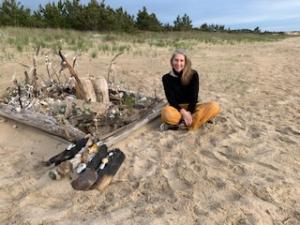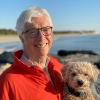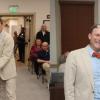This farewell beach walk, as the curtain falls on the wonderful adventure of these columns, is a labor of love in more ways than one.
The setting is Cape Henlopen State Park. The scene is Herring Point.
My awe for Henlopen has grown in quantum leaps throughout this project as I’ve uncovered the mysteries below the surface. The big take-away is that, right here at our doorstep, is a ground zero where the planet is continually in flux seeking balance. The beach is a matrix of complex connections and relationships, actions and reactions re-engineering the surrounding landscape. What I used to see as simply waves and wind, sand and grass, I now understand as nature’s toolbox, foundational building blocks in evolutionary experiments.
This dynamic of change carries over into the beach’s effect on visitors. I’ve also come to appreciate its extraordinary social power. Recreation, of course. Swimming and sand castles. But perhaps even more importantly, it is an agent of personal recalibration. As you look into a vast sky or unbounded horizon, you can almost feel the molecules in your body breathing more easily. Or maybe it’s due to the rhythmic white noise of the surf, quieting the mind like a meditative mantra. Whatever the cause, on the beach your inner space expands.
Which leads naturally to Cait’s Cairn, an entryway into another human realm catalyzed by the beach.
Cait Clarke, whose ‘official’ residence is Washington, has lived in Lewes throughout COVID. She’s taken to early morning beach walks, hooked on being there for sunrise. Which, for those unfamiliar with the reddish-orange glow cast at sun’s first breaking, defines heavenly.
One blustery day, alone in the drizzle, she grew steadily more bummed out by the human detritus scattered in the sand. Plastic bottles, fast-food cartons, beer cans, cigarette butts.
Being one of those engaged spirits who believes the world can be changed, she found herself sitting on a washed-up log wondering how to induce others to maintain the pristine purity of a litter-free beach.
Inspiration struck … She would create an art installation!
Over the next weeks, a construction of driftwood, feathers, branches, and other odds and ends took form at Herring Point, a hundred yards north of the surfer’s breakwall. It became a kind of landmark, conspicuous enough to draw attention. At its center, Cait put garbage bags in an old yogurt container; dangling from branches and stubs she hung stylish shell necklaces, which she taught herself to make.
Then she posted a sign: “In respect to the beach, please take a trash bag. In gratitude from the sea, please take a necklace.”
The site, which another morning walker christened “Cait’s Cairn,” attracts gaggles of the curious. Build it and they will come! Some stranger’s posting on Facebook quickly got upwards of 100 likes. The installation has become participatory art as people add their own offerings to the design. Despite a few big storms and several incidents of malice, over the months the cairn remains intact. The challenge is to maintain the necklace inventory; Cait replenishes it daily with new ones she strings during Zoom business meetings just out of camera range (her colleagues believe she looks down so often because she’s taking notes).
The cairn has spawned a brand extension, a sharing box installed at the foot of the path down to Herring Point. More of Cait’s doing. Lots of forgotten toys show up during her walks. She gathers her finds together, with a sign offering their use for the day (please return afterward for the next batch of children). On a recent visit, in addition to shovels and buckets, there were two beach chairs and three boogie boards.
It may be my imagination, but the beach looks less littered these days. I choose to believe much of the credit goes to Cait’s Cairn.
The adage that “all politics is local” is appropriate to Cait’s Cairn, even though it wasn’t undertaken for partisan purposes. In our era of rancor and distrust, we’re well advised to rethink what politics means in the best of worlds: acting together for the collective good. As well as how we reinstitute the historic institution of ‘a commons’ belonging to nobody but shared by all. That’s why Cape Henlopen State Park exists today – William Penn’s original grant of this land mandated it be community property.
Cait Clarke offers us one not-so-small model of how we can begin to do this.






















































